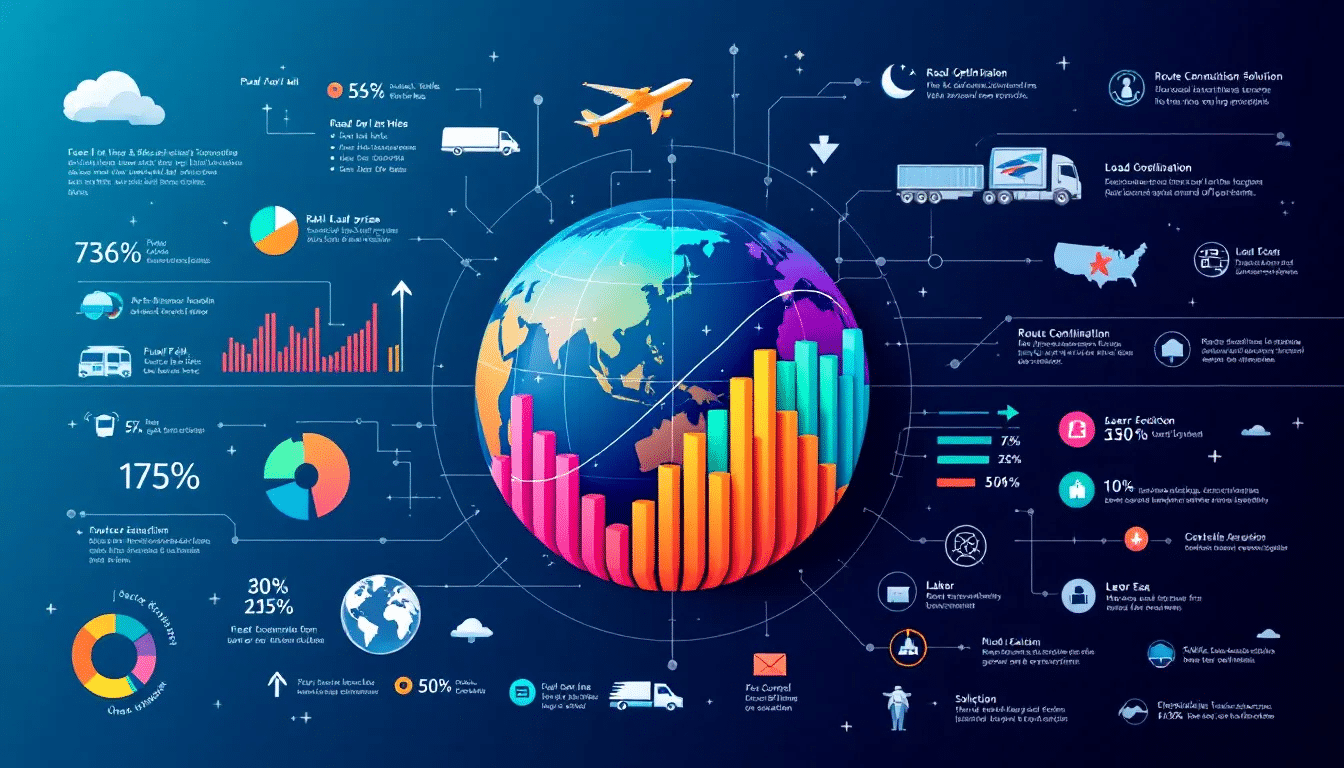Supply chain business intelligence is the process of using advanced analytics tools to gather, process, visualize, and analyze data from throughout your supply chain. It helps uncover actionable insights that you can use to make smarter decisions, improve your efficiency, and optimize supply chain performance.
But, what does business intelligence (BI) look like in modern supply chains, and how can you make the most of the insights it provides?
This article directly explores the real-world applications of BI in supply chains, emphasizing how it drives efficiencies, reduces costs, and helps you adapt to market volatility.
Key Takeaways
- Business intelligence tools analyze data from various sources like ERP, CRM, WMS, TMS, and IoT systems to provide actionable insights that optimize supply chain management, predicting disruptions and improving efficiency.
- Supply chain business intelligence helps improve visibility in your supply chain, provides data-driven insights, reduces your costs, and increases customer satisfaction.
- Successful BI implementation in supply chains requires a well-defined project scope, SMART goals, effective technology integration, and a continuous improvement mindset to adapt to market changes and efficiencies.
What Is Supply Chain Business Intelligence?
Business intelligence guides supply chain operations through market fluctuations, changes in regulation, and evolving customer demands. It involves harnessing data from a variety of sources to streamline the entire supply chain, revealing patterns and generating actionable insights that support informed decision-making.
Supply chain business intelligence collects data from these tools:
- Enterprise Resource Planning (ERP) Systems
- Customer Relationship Management (CRM) Systems
- Warehouse Management Systems (WMS)
- Transportation Management Systems (TMS)
- Internet of Things Systems (IoTS)
Businesses use these tools for demand forecasting, adapt and respond to disruptions in the supply chain, and continuously optimize logistical performance to improve efficiency and transparency.
What is Business Intelligence Used For in the Supply Chain?
Supply chain business intelligence is a complex process that includes a variety of different processes that are essential for identifying, highlighting, and implementing improvements.
Here’s a quick rundown of the different actions you need to take when you perform business intelligence:
- Collecting and Consolidating Data: The various systems that you use collect a wide assortment of data. Some of this is duplicate data, which has to be weeded out, with the remaining data consolidated and standardized in a single location so it’s easy to access.
- Analyzing and Visualizing Data: The data you collect has to be processed and analyzed to uncover trends and valuable insights that you can use. You can perform data analysis using AI and machine learning to save time and improve accuracy along with visualization tools to create digestible dashboards that are easy to follow.
- Monitoring Performance: Once you can easily process and analyze data, you need to define the key metrics you want to improve and track how your current data compares to historical data, industry standards, and goals. Some key performance indicators include order fulfillment rates, on-time delivery, shipping costs, and more.
- Identifying Improvements: Your data collection, analysis, and monitoring should help you pinpoint where you can make improvements at various stages of the supply chain. You might find ways to optimize delivery routes, improve inventory management, or lower supplier costs based on performance.
- Implementing Improvements: Using the insights you’ve uncovered, create solutions for any problem areas in your supply chain. Then, restart the process after implementing your solutions to see if they made a significant impact. It’s important to always look for improvements, which you now have the infrastructure in place to do.
You should also keep stakeholders and partners informed throughout the process to improve transparency and build trust.
What Are The Benefits of Business Intelligence In Supply Chain Management?
Business intelligence helps your supply chain management become better in many ways, including costs, performance, and accuracy. These benefits can drastically improve your overall logistical efficiency and help you maintain high quality standards across your supply chain.
Here’s how.
Improved Visibility
Business intelligence focuses on collecting and highlighting crucial data relating to the various aspects of your supply chain. With the right tools, you’ll be able to track the entire process from start to finish with real-time monitoring to help identify and resolve problems quickly to minimize their impact.
Data-Driven Decision Making
When you implement business intelligence for your supply chain management, it analyzes all the key aspects of your logistics operations to find valuable, actionable insights that you can use to make significant improvements. You’ll be able to manage carrier and supplier relationships, forecast customer demand to improve production and inventory management, identify weak points in your supply chain, and make informed decisions about the future of your business with confidence.
Cost Reduction
Every business wants to save money–and business intelligence makes it easy to find ways you can spend less without impacting performance. Identifying inefficiencies in your operations and remedying discrepancies in things like carrier or supplier performance are just a few ways you can reduce costs with business intelligence.
Customer Satisfaction
The combination of enhanced visibility, accurate inventory management, optimized delivery routes, and cost-effective improvements with supply chain management all provide opportunities for improving customer satisfaction. You can shorten lead times, increase delivery accuracy, and lower costs to create a better customer experience.
The Value of Using An Interactive Business Intelligence Dashboards
Informational accuracy and accessibility are critical to effective business intelligence efforts. BI tools offer interactive dashboards and reports, which turn complex supply chain data into visualizations that are easier to understand while still comprehensive.
With advanced visualization tools, you can transform raw data into clear, actionable insights that serve as a blueprint for strategic planning.
These visualization features—maps, graphs, charts, and diagrams—depict the specific details necessary for informed decision-making. BI dashboards allow for real-time updates and adjustments, always aligned with organizational objectives.
How Interactive Dashboards Help Track Valuable KPIs
With BI tools, you can easily track key metrics throughout your supply chain. You gain full visibility into each process, including sourcing, inventory management, manufacturing, transportation, and delivery.
Once you’ve selected the key performance indicators most important to you, the dashboard will collect and visualize the information so it’s easy to monitor over time.
Some KPIs you can track include:
- On-Time Delivery Rate
- Damage-Free Delivery
- Fill Rate
- Order Accuracy
- Supplier Lead Time
- Supplier Defect Rate
- Transportation Costs
- Return Rates
- Inventory Turnover
- Cash-to-Cash Time Cycle
The insights gleaned from supply chain analytics are actionable, helping you discover inefficiencies, optimize resource allocation, and improve workflows.
The Power of Visibility: How FreightOptics Helped Find Hidden Accounts
Business intelligence platforms both identify and track data, providing you with key better visibility into your entire supply chain.
A Zero Down client had issues with visibility when they lost track of how many accounts were in their shipping portfolio, leading them to pay parcel invoices without any idea if charges were accurate.
With FreightOptics, they were able to gain access to the various accounts they had and implement complete visibility across all modes to ensure they’re not overpaying going forward.
How to Implement Business Intelligence In Your Supply Chain
Implementing BI within the supply chain is a commitment to data-driven decision-making, optimized supply chain processes, and operational efficiency. It helps position your organization for future growth and adaptability in the face of changing regulations, procedures, and customer expectations.
Business intelligence begins with:
- Defining the scope of the project
- Setting clear goals, timelines, and resource requirements
- Ensuring that every step taken is measured
- Making informed decisions
If you want to be successful in your supply chain management, you need the right resources and knowledge, a plan, and the determination to persevere through the complex steps of the process.
Alternatively, you can work with a third-party supply chain BI solution provider to get started quickly and easily.
Set Clear Objectives
A successful BI implementation starts with a thorough understanding of the primary issues and challenges within your supply chain. Your goal is to identify and address any issues in your operations that are holding you back, which is possible with the seamless integration of business intelligence into daily logistical processes.
Objectives for BI implementation should pinpoint activities like data integration and analysis to clarify the purpose and function of the BI tool within the supply chain. You’ll want to find the KPIs that are most important to your business so you can measure your progress towards these objectives over time.
By setting SMART goals and developing a proof of concept, you can target specific issues and ensure the BI solution fulfills its intended role effectively.
Implement Your Technology
Your tools and technology are the backbone of the business intelligence process. If you want to gain valuable insight into your entire supply chain, you’ll have to integrate and implement a variety of different platforms and technology.
You need to choose the management tools you’re going to integrate with your business intelligence platform, create dashboards to track all of the KPIs you’ve defined, and configure your platform to analyze and visualize data for you to monitor.
Monitor and Refine Your Approach
As the industry changes and your needs change, you need to be able to adapt your business intelligence approach as well. Regular evaluations of your BI platform, the KPIs you’re tracking, and your procedure for making changes using the insights you gather help keep you agile and ready for market changes. You should always be ready to change your procedure to improve efficiency and your ability to deal with supply chain disruptions as they happen.
Use Supply Chain Business Intelligence to Improve Your Operations
Supply chain business intelligence drives success with efficient operations and informed decision-making. Adopting the right business intelligence software or partnering with the right solution provider positions you for future success as you continue to refine your daily operations and the entirety of your supply chain.
Embracing a data-driven culture, fostering collaboration, and sharing insights are the stepping stones to securing a competitive advantage with business intelligence solutions. Don’t get left behind!
Frequently Asked Questions
What is the impact of real-time insights in supply chain management?
Real-time insights in supply chain management provide end-to-end visibility and enable proactive decision-making. These benefits ultimately enhance transportation efficiency, optimizing routes, reducing costs, and improving inventory management. This allows stakeholders to monitor operations and swiftly respond to disruptions.
How do BI tools contribute to cost savings in the supply chain?
BI tools contribute to cost savings in the supply chain by automating report generation, identifying inefficiencies, and tracking logistics performance to reduce operational costs without compromising quality or service. This maximizes efficiency and reduces unnecessary expenses.
Can you give an example of how companies use BI to enhance supplier relationships?
Companies like Walmart use business intelligence to enhance supplier relationships by sharing sales data and demand forecasts with suppliers, enabling them to adjust production schedules and foster stronger collaborative relationships.
What are the key considerations for implementing business intelligence in a supply chain?
The key considerations for implementing BI in a supply chain include defining the project scope, understanding challenges, integrating data from various platforms, tracking KPIs, and creating production-efficient schedules.
Why is fostering a data-driven culture important in supply chain operations?
Fostering a data-driven culture in supply chain operations is important because it encourages informed decision-making, improves operational efficiency, and aligns the organization with strategic goals. It also supports transparent data sharing among stakeholders, leading to better collaboration and a more efficient supply chain overall. This enables the organization to leverage insights and optimize processes to adapt to market demands.
Brad McBride, CEO and Founder of Zero Down Supply Chain Solutions is a dynamic leader with over 30 years of experience in the supply chain sector. His journey began at Consolidated Freightways in 1988, where he mastered freight logistics and pricing. His career led him to Eagle Global Logistics, diving into international freight forwarding and leading high-volume shipping projects.
Read More




